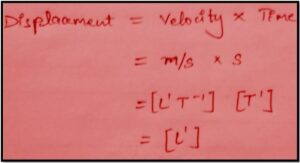
Courses

By Shailendra Singh
|
Updated on 21 Nov 2024, 15:51 IST
Dimensions of Displacement: Welcome to our guide on the dimensions of displacement! In this article, we’ll explore the concept of displacement and its various forms, including linear displacement and angular displacement. We’ll also delve into the dimensional formulas for each type of displacement.
Displacement is a fundamental concept in physics that describes the change in position of an object. It’s important to understand the dimensions of displacement because it helps us analyze and solve problems related to motion.
We’ll start by explaining the dimensional formula of displacement, which is used to express the relationship between displacement and other physical quantities. Then, we’ll move on to the dimensional formula of angular displacement, which is used to describe the rotation of an object around a fixed axis.
By the end of this guide, you’ll have a solid understanding of the dimensions of displacement and how to apply them in various situations. So, let’s dive in and explore the fascinating world of displacement!
The shortest distance between two points, dimensional displacement, tends to be along a straight line. A displacement is a long number that represents the distance between two places. This could also be attributed to two other sets of coordinates if necessary.
The distance travelled from a starting location, excluding the direction of travel, is referred to as displacement. For measurement, we employ the unit meters,’ and it is regarded as a vector quantity. The magnitude of a displacement is measured in terms of its size rather than its direction. The difference between the motion’s beginning position and its conclusion is used to calculate displacement. A displacement in the opposite direction would be shown if the negative sign was included in the equation. If necessary, include the negative sign while solving displacement problems.
Dimensional Formula for Displacement – M0L1T0.
The SI unit of measurement for displacement is the metre (m). A change in the position of a particle in a specific direction over a specified time interval is commonly referred to as displacement of a dimension.


It is critical to take a holistic approach to every facet of a subject’s chapter. It will not only adequately prepare you for the exam, but will also clarify your understanding of each topic. It will help you pass the JEE exam’s conceptual problems. The number of questions from the chapter unit and dimensions would be one or two, with a weightage of roughly four marks.

The distance travelled from a starting location, excluding the direction of travel, is referred to as displacement. Distance, on the other hand, is just the total distance travelled in any direction.
The position of an object after a certain amount of time is referred to as displacement. Velocity, on the other hand, is the rate of motion in a specific direction at any given time.
The size of a displacement is measured in terms of its magnitude, not its direction. It's merely a number with a unit attached to it.